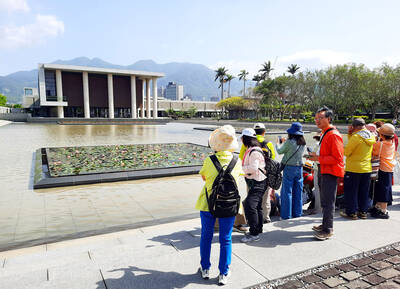The first Toasteria, just off of Zhongxiao East Road (忠孝東路), is a postage-stamp-size place serving panini-style grilled-cheese sandwiches that’s popular for quick bites or take-out orders. With only two tables and seating for up to six at the bar, there’s not room for much else, and patrons are often seen milling around the front waiting for a place to sit.
Owner Tomer Feldman has changed things at his second location in the Shida area. With seating for 30, it’s more than four times the size of the original. The restroom is nearly the size of the first Toasteria and is beautifully outfitted with a wooden bench, huge mirror and a sink made from a refitted wok. Customers joke that they are going to move into it.
What hasn’t changed is the stylish color palette of mustard and earth tones, the use of copper and reclaimed wood, an open kitchen layout and the delicious comfort food on offer.
A thick L-shaped bar dominates the restaurant, its counter fencing in the open kitchen. All the wood furnishings are made from reused word, except for the chairs. The bar itself is made from railway trestles of deeply smoked oak. All the lighting fixtures other than the recessed lights are from an antiques and curio shop that Feldman frequents — he designed the bar around a sideboard he found there.
Feldman gutted the interior and started from scratch to create an ambient, airy space suffused with amber lighting.
The tables are topped with collages Feldman created using clippings from the Village Voice. Under a copper countertop facing the street is a glass-enclosed terrarium filled with plants. Pieces of driftwood are artfully placed throughout.
The expanded space comes with an extended menu, made possible by the installation of a teppanyaki grill, a large toaster oven and a frozen margarita machine.
I tried one of the new Asian-Mediterranean fusion sandwiches, teriyaki steak (NT$170), and my companion had the Med salmon (NT$170). We shared a fried fish salad. The steak sandwich was served medium rare, with grilled onions, and a tangy semi-sweet teriyaki sauce that soaked nicely into the bread. Crisp slices of radish offset the tender meat, and melted cheddar oozed out of every bite. The Med salmon was a simple salmon filet with feta and tomatoes, enlivened with olives, capers and onions. Also available at the original location, the fried fish salad (NT$165) is made of tender chunks of white fish, battered and fried, and stacked on a bed of watercress, lettuce, onions, tomato and beetroot drizzled with Feldman’s homemade aioli dressing. The salad is served with grilled triangles of bread — specially made for Toasteria with no sugar and extra yeast.
We spent a good part of the evening drinking very reasonably priced margaritas (NT$120 each). Despite coming from a machine they were top-notch, made with white Jose Cuervo Clasico, and served in a salted glass and topped with mint and lemon.

When the South Vietnamese capital of Saigon fell to the North Vietnamese forces 50 years ago this week, it prompted a mass exodus of some 2 million people — hundreds of thousands fleeing perilously on small boats across open water to escape the communist regime. Many ultimately settled in Southern California’s Orange County in an area now known as “Little Saigon,” not far from Marine Corps Base Camp Pendleton, where the first refugees were airlifted upon reaching the US. The diaspora now also has significant populations in Virginia, Texas and Washington state, as well as in countries including France and Australia.

On April 17, Chinese Nationalist Party (KMT) Chairman Eric Chu (朱立倫) launched a bold campaign to revive and revitalize the KMT base by calling for an impromptu rally at the Taipei prosecutor’s offices to protest recent arrests of KMT recall campaigners over allegations of forgery and fraud involving signatures of dead voters. The protest had no time to apply for permits and was illegal, but that played into the sense of opposition grievance at alleged weaponization of the judiciary by the Democratic Progressive Party (DPP) to “annihilate” the opposition parties. Blamed for faltering recall campaigns and faced with a KMT chair

Article 2 of the Additional Articles of the Constitution of the Republic of China (中華民國憲法增修條文) stipulates that upon a vote of no confidence in the premier, the president can dissolve the legislature within 10 days. If the legislature is dissolved, a new legislative election must be held within 60 days, and the legislators’ terms will then be reckoned from that election. Two weeks ago Taipei Mayor Chiang Wan-an (蔣萬安) of the Chinese Nationalist Party (KMT) proposed that the legislature hold a vote of no confidence in the premier and dare the president to dissolve the legislature. The legislature is currently controlled

Dull functional structures dominate Taiwan’s cityscapes. But that’s slowly changing, thanks to talented architects and patrons with deep pockets. Since the start of the 21st century, the country has gained several alluring landmark buildings, including the two described below. NUNG CHAN MONASTERY Dharma Drum Mountain (法鼓山, DDM) is one of Taiwan’s most prominent religious organizations. Under the leadership of Buddhist Master Sheng Yen (聖嚴), who died in 2009, it developed into an international Buddhist foundation active in the spiritual, cultural and educational spheres. Since 2005, DDM’s principal base has been its sprawling hillside complex in New Taipei City’s Jinshan District (金山). But